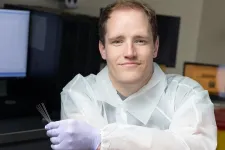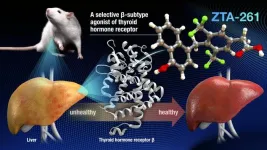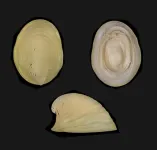(Press-News.org) MINNEAPOLIS / ST. PAUL (08/06/2024) — Researchers at the University of Minnesota, have developed a new visual diagnostic technique that can be used to advance early detection for neurodegenerative diseases like Parkinson's disease and similar diseases that affect animals, including Chronic Wasting Disease in deer.
The research is published in npj Biosensing, a peer-reviewed scientific journal published by Nature.
Named Cap-QuIC (Capillary-enhanced Quaking-Induced Conversion), researchers will now be able to distinguish infected samples with the naked eye, which makes testing more accessible and cost-effective. This new method builds upon the researchers' previous groundbreaking diagnostic technique that allowed for faster and more accurate disease detection.
"The simplicity and efficiency of Cap-QuIC could lower the barriers to routine screening for neurodegenerative diseases, ultimately leading to earlier intervention and better patient outcomes," said University of Minnesota Professor Hye Yoon Park, a senior co-author of the paper and professor of electrical and computer engineering in the College of Science and Engineering.
Parkinson’s disease is characterized by the accumulation of misfolded alpha-synuclein proteins—proteins found in nerve cells in the brain. The disease affects millions worldwide and poses significant challenges in early diagnosis and treatment.
Most diagnoses today come from the observation of a person’s external symptoms in clinical settings during advanced stages of disease. Late detection can limit the potential therapeutic options. Current early diagnosis relies on fragile and expensive equipment for testing that limits access in some areas, especially in developing countries.
The differential action, first discovered by Peter Christenson, an electrical and computer engineering postdoctoral researcher and first author on this paper, is influenced by the protein’s surface characteristics, which vary significantly between healthy and diseased states.
"I remember I was in the lab using an expensive fluorescent reader to determine if my samples were positive or negative. As I continued the experiment, I was able to predict the status of each sample before putting it into the reader,” Christenson said. “Then it hit me, ‘Why do I even bother using this expensive piece of equipment if I can tell the status of samples by eye?’ This was the breakthrough moment that led us to developing our new misfolded protein detection assay,"
The Cap-QuIC visual method leverages simple action to detect misfolded alpha-synuclein proteins. The team demonstrated that they could use glass capillaries—small test tubes designed to hold biological materials—to distinguish between normal and disease-associated proteins by observing differences in liquid movement within the tubes.
"This method is not only applicable to Parkinson's but could also accelerate the diagnosis of other similar diseases, including Chronic Wasting Disease in deer," said Peter Larsen, an associate professor of veterinary and biomedical sciences in the College of Veterinary Medicine.
The researchers tested the technique on tissues from wild white-tailed deer infected with Chronic Wasting Disease and showed that Cap-QuIC could classify samples with high sensitivity and specificity.
"Our Cap-QuIC procedure represents a major advancement in point-of-care neurodegenerative disease diagnostics," said Professor Sang-Hyun Oh, a McKnight Professor and Bordeau Chair in the College of Science and Engineering’s Department of Electrical and Computer Engineering and senior co-author of the paper. "By simplifying the detection process, we can potentially diagnose Parkinson's disease earlier, which is crucial for effective management and treatment."
Larsen and Oh lead the University’s Minnesota Center for Prion Research and Outreach (MNPRO) that brings faculty and external team members together from across various disciplines to study protein misfolding diseases such as Alzheimer's disease, Parkinson's disease, Chronic Wasting disease, and ALS.
In addition to Park, Christenson, Larsen, and Oh, the team involved in this paper included University of Minnesota researchers Hyeonjeong Jeong, Hyerim Ahn, Manci Li, Rachel Shoemaker, and Gage Rowden.
This research was funded by a combination of public and private funds. Portions of the research were funded by new faculty startup funding awarded to Park from the University of Minnesota. Christenson was supported by the Mistletoe Research Fellowship from the Momental Foundation and the Interdisciplinary Doctoral Fellowship at the University of Minnesota. The Chronic Wasting Disease research was funded by the Minnesota Environment and Natural Resources Trust Fund; the Minnesota Agricultural Experiment Station Rapid Agricultural Response Fund; and the Minnesota Agricultural, Research, Education, Extension and Technology Transfer program.
To read the entire research paper entitled, “Visual detection of misfolded alpha-synuclein and prions via capillary-based quaking-induced conversion assay (Cap-QuIC),” visit the npj Biosensing website.
END
New visual technique could advance early detection of neurodegenerative diseases
Distinguishing infected samples with the naked eye will make testing more accessible and cost-effective
2024-08-06
ELSE PRESS RELEASES FROM THIS DATE:
ALS diagnosis and survival linked to metals in blood, urine
2024-08-06
People with higher levels of metals found in their blood and urine may be more likely to be diagnosed with — and die from — amyotrophic lateral sclerosis, or ALS, a University of Michigan-led study suggests.
Researchers have known that ALS, a rare but fatal neurodegenerative condition, is influenced by genetic and environmental factors, including exposure to pesticides and metals.
This latest study examined the levels of metals in the blood and urine of people with and without ALS, finding that exposure to individual and mixtures of metals is associated with a greater risk for ALS and shorter survival.
The ...
Anxiety reframed can make business pitches more effective
2024-08-06
PULLMAN, Wash. – It may be possible to turn anxiety into a superpower in some scenarios, recent research with entrepreneurs indicates.
A Washington State University-led study found that if entrepreneurs preparing to make a funding pitch connected their pitch anxiety to their passion for their venture, judges ranked their performance higher. Perhaps even more importantly, the judges were also more likely to recommend them for funding.
This emotion reframing involved the entrepreneurs recognizing that they were feeling anxious partly because the project means so much to them. Entrepreneurs who tried other strategies ...
Study finds refined corn flour with added corn bran can lower cholesterol
2024-08-06
The findings of the randomized crossover clinical trial, available online now and slated to appear in an upcoming issue of the Journal of Nutrition, reveal simply swapping in foods made from refined corn flour + corn bran can lower LDL cholesterol concentrations by anywhere from 5% - 13.3% in just four weeks.
The trial compared the impact of whole-grain corn meal, refined corn meal, and a blend (refined corn meal plus corn bran) and found that 70% of the participants saw significant reductions in LDL cholesterol concentrations when consuming the blend. For the other corn flours, participants did not see a decrease in their LDL or total cholesterol ...
Carvings at ancient monument may be world’s oldest calendar
2024-08-06
Markings on a stone pillar at a 12,000 year-old archaeological site in Turkey likely represent the world’s oldest solar calendar, created as a memorial to a devastating comet strike, experts suggest.
The markings at Göbekli Tepe in southern Turkey – an ancient complex of temple-like enclosures adorned with intricately carved symbols – could record an astronomical event that triggered a key shift in human civilisation, researchers say.
The research suggests ancient people were able to record their observations of the sun, moon and constellations in ...
Sport or snack? How our brain decides
2024-08-06
In brief:
The chemical messenger orexin and the orexin neurons in the brain mediate the decision between exercise and snacking. Researchers at ETH Zurich made this discovery in mice. The results are likely to be transferable to humans.
In the experiment, mice with a blocked orexin system opted more frequently for the milkshake offered them and less for exercise.
These results could help in researching and developing new strategies to promote physical activity in people.
Should I go and exercise, or would I rather go to the café ...
A new way of thinking about the economy could help protect the Amazon, and help its people thrive
2024-08-06
To protect the Amazon and support the wellbeing of its people, its economy needs to shift from environmentally harmful production to a model built around the diversity of indigenous and rural communities, and standing forests.
A group of conservationists from Bolivia, Brazil, Peru, Ecuador, the US and the UK say that current conservation and development efforts will never sustain or scale without systemic changes in how economies are designed.
Despite extensive destruction of the Amazon in the name of economic development, Amazonian communities have seen little improvement in income, life expectancy, and education. The researchers have ...
Controlling lipid levels with less side effects possible with new drug
2024-08-06
Scientists at Nagoya University in Japan have made a significant breakthrough in treating lipid disorders. They have developed a new compound, ZTA-261, which selectively binds to the thyroid hormone receptor beta (THRβ). THRβ plays an important role in the regulation of lipid metabolism, which affects lipid levels in the blood. Mice administered the drug showed decreased lipid levels in the liver and blood, with fewer side effects in the liver, heart, and bones compared to existing compounds. These findings, published in Communications Medicine, suggest that ZTA-261 ...
Research spotlight: Analyzing the effectiveness of heart therapies and outcomes for patients with chip
2024-08-06
Nicholas A. Marston, MD, MPH, of the TIMI Study Group and Carl J. and Ruth Shapiro Cardiovascular Center at Brigham and Women’s Hospital, is the corresponding author of a paper published in Nature Medicine, “Clonal hematopoiesis, cardiovascular events and treatment benefit in 63,700 individuals from five TIMI randomized trials.”
How would you summarize your study for a lay audience?
Clonal hematopoiesis of indeterminate potential (CHIP) is a condition that promotes the multiplication of blood stem cells in the body and increases the ...
Soft gold enables connections between nerves and electronics
2024-08-06
Gold does not readily lend itself to being turned into long, thin threads. But researchers at Linköping University in Sweden have now managed to create gold nanowires and develop soft electrodes that can be connected to the nervous system. The electrodes are soft as nerves, stretchable and electrically conductive, and are projected to last for a long time in the body.
Some people have a “heart of gold”, so why not “nerves of gold”? In the future, it may be possible to use this precious metal in soft interfaces to connect electronics to the nervous system for medical ...
The race to discover biodiversity: 11 new marine species and a new platform for rapid species description
2024-08-06
Accelerating global change continues to threaten Earth’s vast biodiversity, including in the oceans, which remain largely unexplored. To date, only a small fraction of an estimated two million total living marine species have been named and described. A major challenge is the time it takes to scientifically describe and publish a new species, which is a crucial step in studying and protecting these species. The current scientific and publishing landscape often results in decade-long delays (20-40 years) from the discovery of a new species to its official description. As an ...
LAST 30 PRESS RELEASES:
First Editorial of 2026: Resisting AI slop
Joint ground- and space-based observations reveal Saturn-mass rogue planet
Inheritable genetic variant offers protection against blood cancer risk and progression
Pigs settled Pacific islands alongside early human voyagers
A Coral reef’s daily pulse reshapes microbes in surrounding waters
EAST Tokamak experiments exceed plasma density limit, offering new approach to fusion ignition
Groundbreaking discovery reveals Africa’s oldest cremation pyre and complex ritual practices
First breathing ‘lung-on-chip’ developed using genetically identical cells
How people moved pigs across the Pacific
Interaction of climate change and human activity and its impact on plant diversity in Qinghai-Tibet plateau
From addressing uncertainty to national strategy: an interpretation of Professor Lim Siong Guan’s views
Clinical trials on AI language model use in digestive healthcare
Scientists improve robotic visual–inertial trajectory localization accuracy using cross-modal interaction and selection techniques
Correlation between cancer cachexia and immune-related adverse events in HCC
Human adipose tissue: a new source for functional organoids
Metro lines double as freight highways during off-peak hours, Beijing study shows
Biomedical functions and applications of nanomaterials in tumor diagnosis and treatment: perspectives from ophthalmic oncology
3D imaging unveils how passivation improves perovskite solar cell performance
Enriching framework Al sites in 8-membered rings of Cu-SSZ-39 zeolite to enhance low-temperature ammonia selective catalytic reduction performance
AI-powered RNA drug development: a new frontier in therapeutics
Decoupling the HOR enhancement on PtRu: Dynamically matching interfacial water to reaction coordinates
Sulfur isn’t poisonous when it synergistically acts with phosphine in olefins hydroformylation
URI researchers uncover molecular mechanisms behind speciation in corals
Chitin based carbon aerogel offers a cleaner way to store thermal energy
Tracing hidden sources of nitrate pollution in rapidly changing rural urban landscapes
Viruses on plastic pollution may quietly accelerate the spread of antibiotic resistance
Three UH Rainbow Babies & Children’s faculty elected to prestigious American Pediatric Society
Tunnel resilience models unveiled to aid post-earthquake recovery
Satellite communication systems: the future of 5G/6G connectivity
Space computing power networks: a new frontier for satellite technologies
[Press-News.org] New visual technique could advance early detection of neurodegenerative diseasesDistinguishing infected samples with the naked eye will make testing more accessible and cost-effective





